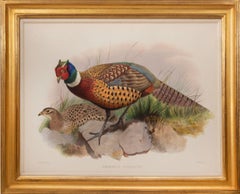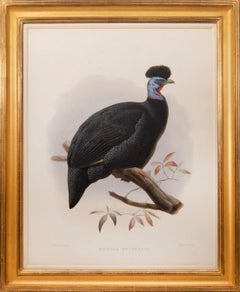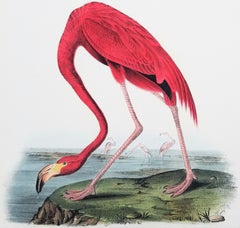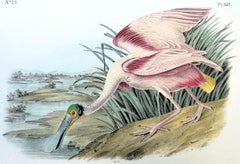Gouache Animal Prints
to
2
Overall Width
to
Overall Height
to
2
2
1
1
2
1
1
2
2
4
2
2
2
1
2
2
Artist: Joseph Wolf
Medium: Gouache
Four Pheasants
By Joseph Wolf
Located in London, GB
WOLF, Joseph (artist)
Four Pheasants
London, For the author, Red Lion Court, Fleet Street, 1871
Four original hand-coloured lithographic plates by Joseph Smit after Joseph Wo...
Category
1870s Naturalistic Gouache Animal Prints
Materials
Watercolor, Gouache, Lithograph
Two Guinea Fowl
By Joseph Wolf
Located in London, GB
WOLF, Joseph (artist).
Two Guinea Fowl
London For the author, Red Lion Court, Fleet Street 1871
Two original hand-coloured lithographic plates by Joseph Smit after Joseph Wolf. ...
Category
1870s Gouache Animal Prints
Materials
Paper, Watercolor, Gouache, Lithograph
Related Items
American Flamingo /// John James Audubon Natural History Ornithology Bird Litho
Located in Saint Augustine, FL
Artist: John James Audubon (American, 1785-1851)
Title: "American Flamingo" (Plate 375, No. 75)
Portfolio: The Birds of America, First Royal Octavo E...
Category
1840s Victorian Gouache Animal Prints
Materials
Watercolor, Lithograph
Roseate Spoonbill /// John James Audubon Natural History Ornithology Water Bird
Located in Saint Augustine, FL
Artist: John James Audubon (American, 1785-1851)
Title: "Roseate Spoonbill" (Plate 362, No. 73)
Portfolio: The Birds of America, First Royal Octavo Edition
Year: 1840-1844
Medium: Original Hand-Colored Lithograph on wove paper
Limited edition: approx. 1,200
Printer: John T. Bowen, Philadelphia, PA
Publisher: John James Audubon and J.B. Chevalier, New York, NY and Philadelphia, PA
Sheet size: 6.75" x 10.44"
Image size: 5" x 7.63"
Condition: In excellent condition
Very rare
The "Roseate Spoonbill" is one of the very top, absolute most desirable birds from Audubon's famous "Birds of America" series
Notes:
Provenance: private collection - Fleming Island, FL. Lithography and hand-coloring by American artist John T. Bowen (1801-c.1856). Comes from Audubon's famous seven volume portfolio "The Birds of America", First Royal Octavo Edition (1840-1844), which consists of 500 hand-colored lithographs.
Based on a composition painted in Florida in 1831 or 1832. "This beautiful and singular bird" was prized for its wings and tail feathers which were made into fans in St. Augustine.
The roseate spoonbill is a gregarious wading bird of the ibis and spoonbill family, Threskiornithidae. It is a resident breeder in both South and North America. The roseate spoonbill's pink color is diet-derived, consisting of the carotenoid pigment canthaxanthin, like the American flamingo.
To make 'The Birds of America' more affordable and widely available, in 1839 John James Audubon began the first octavo edition, a smaller version of the folio which was printed and hand-colored by J. T. Bowen in Philadelphia. Employing a new invention, the camera lucida, the images were reduced in size, rendered in intermediate drawings by John James Audubon and his son John Woodhouse, and then drawn onto lithographic stones. These miniatures exhibit a remarkable amount of attention to quality and detail, as well as a meticulous fidelity to the larger works. Some compositional changes were made in order to accommodate the smaller format. Like the Havell edition, John James Audubon’s first...
Category
1840s Victorian Gouache Animal Prints
Materials
Watercolor, Lithograph
Whooping Crane /// John James Audubon Ornithology Natural History Wading Birds
Located in Saint Augustine, FL
Artist: John James Audubon (American, 1785-1851)
Title: "Whooping Crane" (Plate 313, No. 63)
Portfolio: The Birds of America, First Royal Octavo Edition
Year: 1840-1844
Medium: Origi...
Category
1840s Victorian Gouache Animal Prints
Materials
Watercolor, Lithograph
Snowy Heron /// John James Audubon Natural History Ornithology Snowy Egret Bird
Located in Saint Augustine, FL
Artist: John James Audubon (American, 1785-1851)
Title: "Snowy Heron" (Plate 374, No. 75)
Portfolio: The Birds of America, First Royal Octavo Edition
Year: 1840-1844
Medium: Original...
Category
1840s Victorian Gouache Animal Prints
Materials
Watercolor, Lithograph
"Sandwich Tern' Antique Hand Colored Lithograph
Located in Soquel, CA
"Sandwich Tern' Antique Hand Colored Lithograph
Delicately rendered naturalist drawing of a sandwich tern from the 1903 edition of "A History of British Birds" by F.O. Morris. This...
Category
Early 1900s Naturalistic Gouache Animal Prints
Materials
Paper, Watercolor, Lithograph
American Anhinga - Snake Bird /// John James Audubon Ornithology Natural History
Located in Saint Augustine, FL
Artist: John James Audubon (American, 1785-1851)
Title: "American Anhinga - Snake Bird" (Plate 420, No. 84)
Portfolio: The Birds of America, First Royal Octavo Edition
Year: 1840-1844
Medium: Original Hand-Colored Lithograph on wove paper
Limited edition: approx. 1,200
Printer: John T. Bowen, Philadelphia, PA
Publisher: John James Audubon and J.B. Chevalier, New York, NY and Philadelphia, PA
Sheet size: 10" x 6.69"
Image size: 6.63" x 4.63"
Condition: Minor toning to sheet and some faint discoloration in margins. Old glue staining along right binding edge as normal. It is otherwise in very good condition with strong colors
Notes:
Provenance: private collection - Cleveland, OH. Lithography and hand-coloring by American artist John T. Bowen (1801-c.1856). Comes from Audubon's famous seven volume portfolio "The Birds of America", First Royal Octavo Edition (1840-1844), which consists of 500 hand-colored lithographs. The preceding 1836 Havell edition of this work has a different title: "Black-bellied Darter", (Plate: CCCXVI - 396, No. 64).
Based on a drawing inscribed "New Orleans 1822 - redrawn ... 1836". This conspicuous bird had various names including "water turkey" and "Bec à Lancette".
The Anhinga, sometimes called snakebird, darter, American darter, or water turkey, is a water bird of the warmer parts of the Americas. The word anhinga comes from a'ñinga in the Brazilian Tupi language and means "devil bird" or "snake bird".
To make 'The Birds of America' more affordable and widely available, in 1839 John James Audubon began the first octavo edition, a smaller version of the folio which was printed and hand-colored by J. T. Bowen in Philadelphia. Employing a new invention, the camera lucida, the images were reduced in size, rendered in intermediate drawings by John James Audubon and his son John Woodhouse, and then drawn onto lithographic stones. These miniatures exhibit a remarkable amount of attention to quality and detail, as well as a meticulous fidelity to the larger works. Some compositional changes were made in order to accommodate the smaller format. Like the Havell edition, John James Audubon’s first...
Category
1840s Victorian Gouache Animal Prints
Materials
Watercolor, Lithograph
Wilson’s Petrel - Mother Carey’s Chicken /// Ornithology Bird Seascape Audubon
Located in Saint Augustine, FL
Artist: John James Audubon (American, 1785-1851)
Title: "Wilson’s Petrel - Mother Carey’s Chicken" (Plate 460, No. 92)
Portfolio: The Birds of America, F...
Category
1840s Victorian Gouache Animal Prints
Materials
Watercolor, Lithograph
Long-billed Curlew (City of Charleston) /// Ornithology John James Audubon Bird
Located in Saint Augustine, FL
Artist: John James Audubon (American, 1785-1851)
Title: "Long-billed Curlew (City of Charleston)" (Plate 355, No. 71)
Portfolio: The Birds of America, First Royal Octavo Edition...
Category
1840s Victorian Gouache Animal Prints
Materials
Watercolor, Lithograph
Townsend's Cormorant /// John James Audubon Ornithology Bird Art Natural History
Located in Saint Augustine, FL
Artist: John James Audubon (American, 1785-1851)
Title: "Townsend's Cormorant" (Plate 418, No. 84)
Portfolio: The Birds of America, First Royal Octavo Edition
Year: 1840-1844
Medium: Original Hand-Colored Lithograph on wove paper
Limited edition: approx. 1,200
Printer: John T. Bowen, Philadelphia, PA
Publisher: John James Audubon and J.B. Chevalier, New York, NY and Philadelphia, PA
Sheet size: 10.13" x 6.5"
Image size: 4.38" x 5"
Condition: Light toning to sheet. Some light foxing and small areas of discoloration. Remnants of mounting tape from previous framing on verso. The white background was recently also hand-colored. In otherwise good condition with strong colors
Notes:
Provenance: private collection - Nashville, TN; acquired from a gallery in Nashville, TN. Lithography and hand-coloring by American artist John T. Bowen (1801-c.1856). Comes from Audubon's famous seven volume portfolio "The Birds of America", First Royal Octavo Edition (1840-1844), which consists of 500 hand-colored lithographs.
Based on a composition probably painted in London in 1838, from a specimen obtained near the mouth of the Columbia River.
Brandt's cormorant is a strictly marine bird of the cormorant family of seabirds that inhabits the Pacific coast of North America. It ranges, in the summer, from Alaska to the Gulf of California, but the population north of Vancouver Island migrates south during the winter.
To make 'The Birds of America' more affordable and widely available, in 1839 John James Audubon began the first octavo edition, a smaller version of the folio which was printed and hand-colored by J. T. Bowen in Philadelphia. Employing a new invention, the camera lucida, the images were reduced in size, rendered in intermediate drawings by John James Audubon and his son John Woodhouse, and then drawn onto lithographic stones. These miniatures exhibit a remarkable amount of attention to quality and detail, as well as a meticulous fidelity to the larger works. Some compositional changes were made in order to accommodate the smaller format. Like the Havell edition, John James Audubon’s first...
Category
1840s Victorian Gouache Animal Prints
Materials
Watercolor, Lithograph
Black Rat, Old & Young: A 1st Octavo Edition Audubon Hand-colored Lithograph
Located in Alamo, CA
This is an original 19th century 1st octavo edition John James Audubon hand-colored lithograph entitled "Black Rat, Old and Young", No. 5, Plate XXIII, 23, from Audubon's "Quadrupeds...
Category
Mid-19th Century Naturalistic Gouache Animal Prints
Materials
Lithograph
$300 Sale Price
20% Off
H 7 in W 10.5 in
Mango Hummingbirds: An Original 19th C. Audubon Hand-colored Bird Lithograph
Located in Alamo, CA
This is an original John James Audubon hand-colored lithograph entitled "Mango Humming bird, 1. 2. Males. 3. Female. Bignonia grandifolia", No. 51, Plate 251 from Audubon's "Birds of America, lithographed, printed and colored by JT Bowen and published in Philadelphia between 1870-1871. The lithograph depicts an adult male hummingbird, labelled 1, in flight above a beautiful flowering plant, a Chinese Trumpet-vine. Another male, labeled 2, is perched on a flower on the left and a female, labelled 3, is perched on a flower on the right.
This hand-colored Audubon bird octavo-size lithograph sheet measures 10.25" high by 6.75" wide. It is in excellent condition. The original text pages, 185-186, from Audubon's 19th century publication are included.
John James Audubon (1785-1851) was a naturalist and artist. He was initially unsuccessful financially prior to the publication of his famous work “The Birds of America”, spending time in debtor’s prison, once stabbing a disgruntled investor in self-defense. However, his obsession with birds and art motivated him to persist in his goal of documenting every bird in America via his watercolor paintings and publishing his works for all to enjoy. Audubon's first illustrations were published in a large elephant folio size. Due to their expense they were purchased in rather small numbers by the wealthy. To reach a larger audience, Audubon, with the help of his sons and J. T. Bowen, published a smaller octavo sized lithograph version, which were much more affordable.
With the success of his bird projects, Audubon then turned his attention to four-legged animals. He explored the Missouri River in 1843 sketching the four-legged animals he encountered in their natural setting. His expedition covered some of the same regions recently explored by Lewis and Clark, traveling from present day Alaska to Mexico. Audubon realized that this was an opportunity to document these animals in the still relatively pristine American wilderness, before man encroached on their environment.
Between 1845 and 1848, Audubon and his sons John Woodhouse Audubon...
Category
Late 19th Century Naturalistic Gouache Animal Prints
Materials
Lithograph
John James AudubonMango Hummingbirds: An Original 19th C. Audubon Hand-colored Bird Lithograph, 1870
$1,260 Sale Price
20% Off
H 10.25 in W 6.75 in
Florida Cormorant /// John James Audubon Ornithology Bird Art Natural History
Located in Saint Augustine, FL
Artist: John James Audubon (American, 1785-1851)
Title: "Florida Cormorant" (Plate 417, No. 84)
Portfolio: The Birds of America, First Royal Octavo Edition
Year: 1840-1844
Medium: Original Hand-Colored Lithograph on wove paper
Limited edition: approx. 1,200
Printer: John T. Bowen, Philadelphia, PA
Publisher: John James Audubon and J.B. Chevalier, New York, NY and Philadelphia, PA
Sheet size: 6.5" x 10.44"
Image size: 3.75" x 6.25"
Condition: Some minor discoloration upper center in margin. In excellent condition with strong colors
Notes:
Provenance: private collection - Cleveland, OH. Lithography and hand-coloring by American artist John T. Bowen (1801-c.1856). Comes from Audubon's famous seven volume portfolio "The Birds of America", First Royal Octavo Edition (1840-1844), which consists of 500 hand-colored lithographs.
Based on a composition painted in the Florida Keys on April 26, 1832, Audubon's forty-seventh birthday.
The double-crested cormorant (Nannopterum auritum) is a member of the cormorant family of water birds. It is found near rivers and lakes and in coastal areas and is widely distributed across North America, from the Aleutian Islands in Alaska down to Florida and Mexico. Measuring 70–90 cm (28–35 in) in length, it is entirely black except for a bare patch of orange-yellow facial skin and some extra plumage that it exhibits in the breeding season when it grows a double crest in which black feathers are mingled with white. Five subspecies are recognized. It mainly eats fish and hunts by swimming and diving. Its feathers, like all cormorants, are not waterproof, and it must dry them out after spending time in the water. Once threatened by the use of DDT, the numbers of this bird have increased markedly in recent years.
To make 'The Birds of America' more affordable and widely available, in 1839 John James Audubon began the first octavo edition, a smaller version of the folio which was printed and hand-colored by J. T. Bowen in Philadelphia. Employing a new invention, the camera lucida, the images were reduced in size, rendered in intermediate drawings by John James Audubon and his son John Woodhouse, and then drawn onto lithographic stones. These miniatures exhibit a remarkable amount of attention to quality and detail, as well as a meticulous fidelity to the larger works. Some compositional changes were made in order to accommodate the smaller format. Like the Havell edition, John James Audubon’s first...
Category
1840s Victorian Gouache Animal Prints
Materials
Watercolor, Lithograph
Gouache animal prints for sale on 1stDibs.
Find a wide variety of authentic Gouache animal prints available on 1stDibs. While artists have worked in this medium across a range of time periods, art made with this material during the 21st Century is especially popular. There are many well-known artists whose body of work includes ceramic sculptures. Popular artists on 1stDibs associated with pieces like this include SEGUY, E[ugene] A[lain]., and Joseph Wolf. Frequently made by artists working in the Art Deco, Contemporary, all of these pieces for sale are unique and many will draw the attention of guests in your home. Not every interior allows for large Gouache animal prints, so small editions measuring 0.5 inches across are also available
Recently Viewed
View AllMore Ways To Browse
Manetti Saverio
Natural History Museum Vintage Prints
Penguin Lithograph
Peter Klucik
Pheasant Engraving
Picasso Dove Of Peace
Picasso Le Taureau
Picasso Rooster
Ronald Smith
Rooster Print Picasso
Salvador Dali Argus
Salvador Dali Unicorn
Sam Savitt
Shore Bird Print
Space Elephant Dali
Szabolcs Bozo
The Toad Picasso
Vintage Forest Service Posters



